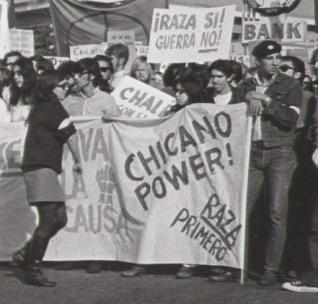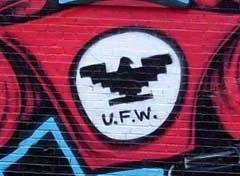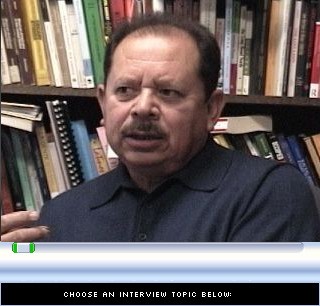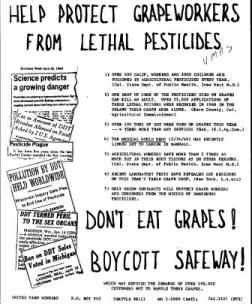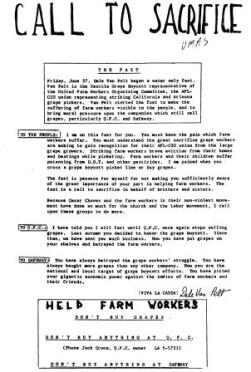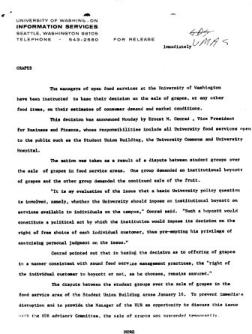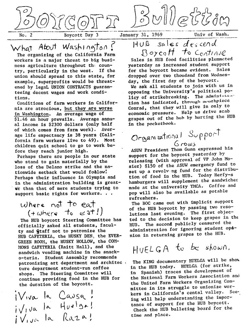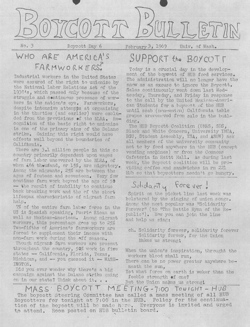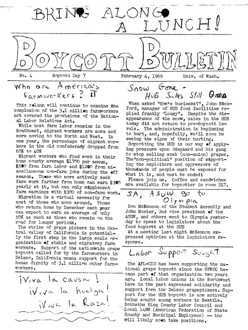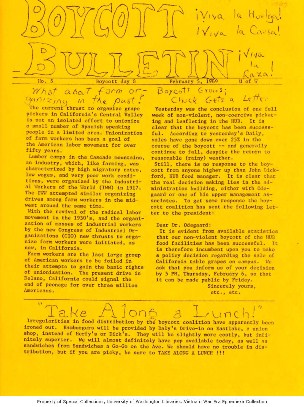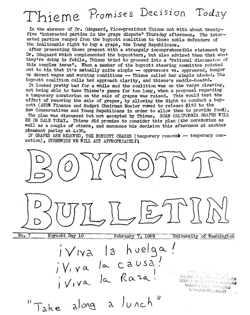The University of Washington became well known in the late 1960s for student mobilizations that at times rivaled activist hubs such as Berkeley and Columbia. Thousands demonstrated against the war in Vietnam, against militarism on campus, for civil rights. Among the protesters were students of color, primarily African Americans and Chicanos, who created organizations based on race and class and demanded proactive measures to address racial inequality, especially in higher education.
Chicano1 students were recruited into the UW for the first time by the Special Education Program, enrolling in the fall of 1968. There they were politically activated by their personal connection to the social problems facing Chicanos in Washington, the momentum of the Civil Rights and farm worker movements, and the milieu of radical student mobilization they found on campus. They formed the United Mexican American Students (UMAS), which joined and soon led a campaign in solidarity with one of the Chicano Movement’s central activities: the boycott of California table grapes in support of the United Farm Worker Organizing Committee (UFWOC), which had been on strike since 1965.
This paper will attempt to show that as the UFWOC grape boycott helped galvanize the nascent Chicano Movement on a national scale, the UW boycott effort also helped define and empower UMAS in its early stages. The first rumblings of the campus grape debate began before UMAS came to be, and were attributed to non-Chicano activists by the University of Washington Daily. Soon, however, the campaign’s leadership became identified with UMAS, as the organization gained strength and the campaign moved into its most publicized and intense period: a boycott of all UW food services, which centered around the student union building, known as “the HUB.” The successful boycott made the UW the first campus in the United States to stop selling grapes2 and turned a small group of Chicano students into a force to be reckoned with.
La Raza3 comes to campus
In May of 1968, the UW chapter of the Black Student Union (BSU) waged a successful campaign to make the University more accessible and relevant to African-American students. Their vociferous demands, delivered during a four-hour sit-in at the Administration Building, called for improving recruitment and treatment of minority students, doubling Black enrollment, increasing financial aid and funding for minority student programs, and the creation of Black Studies courses.4
One of the steps President Charles Odegaard took in response was to create the Special Education Program (SEP).5 The program’s goal was to “increase the enrollment of historically underrepresented minority and disadvantaged students” and provide them assistance with academics and adjusting to the university environment. 6 In June, Bill Hilliard, a former counselor for the Department of Penal Institutions and the YMCA,7 was hired to direct recruitment efforts. That summer, he was assisted by eight BSU members who accompanied him on trips around the state to convince “Negro,” “American Indian,” and Mexican-American students to attend the UW.8 One of the group’s recruiting sites was the Yakima Valley, where recruiters talked with many Chicano youth.9 This connection between the BSU and Chicano students would later be strengthened by collaborative efforts on campus.
The new program was successful in enrolling 247 new students of color,10 including 35 Chicanos.11 This brought the total “Hispanic”12population to 60, or 0.19% of the student body of 31,913.13 Before 1968, the UW’s only census of students by ethnicity had been an estimation based on observing students on the Suzzallo Quad (today’s Red Square), but one administrator guesses there was a total of 15-20 Hispanic students before recruiting began.14 Tomás Ybarra-Frausto, who would become a friend and advisor to many Chicano students, claimed that before SEP there were only three.15 By any estimation, Chicanos made up only a tiny fraction of the student population, even after the implementation of a recruitment program.
Attending a large university can be a daunting experience for any first-year student, and this was perhaps especially true for Chicanos from east of the Cascade Range. Erasmo Gamboa, who would later become a Chicano student leader,16 was intimidated by the fact that “there were more people in the HUB than there were in my hometown.” Overwhelmed by the size of campus, he skipped his first day of classes, and happened upon other Chicano students in a U-District coffee shop who were doing the same. Most Chicano students felt isolated, even from each other, because they came from different communities and were spread out in residence halls across the campus. However, some of them quickly recognized their common bonds of culture, ethnicity and class. They shared Mexican roots, spoke Spanish, and came from families that engaged in farm work or other labor.17 They adopted a buddy system to keep tabs on each other and began building a social network that would soon evolve into an influential organization.18
In 1968, the UW, like college campuses across the nation and overseas, was embroiled in social upheaval. Student movements and the police and legal actions that countered them reached a fever pitch in Europe, Mexico, and across the United States. In the spring, the UW chapter of Students for a Democratic Society (SDS) participated in a national campaign of protests, including a class boycott waged by more than 2,000 students. In August, Chicago police viciously attacked protesters at the Democratic National Convention, and the City of Berkeley declared a “civil disaster” as police and protesters clashed in the streets. On September 18, someone set fire to UW’s Clark Hall, which housed the Navy ROTC program, and on October 24, 2,000 UW students “liberated” the Faculty Club after a speech given on campus by Yippie organizer Jerry Rubin.19 These are only a few of the tumultuous events that helped set a militant tone for political student organizations.
Yet Chicanos had even more reason to become politically active than the average student, because a movement of their own was gaining strength. Many political and social organizations had been created during the “Mexican American Generation” of the 1930s. These were focused on the concepts of assimilation into American culture while maintaining pride in Mexican heritage.20 By 1968, the ideology and tactics of Mexican American activism had changed. That year, California’s university campuses were home to about 50 Mexican American student organizations, with thousands of members, many of whom were undergoing an acute radicalization.21 On the morning of March 3, 1968, more than one thousand students walked out of Abraham Lincoln High School in East Los Angeles, protesting the school’s racist teachers and policies, restrictions on students’ freedom of speech, and the lack of Mexican American teachers and curricula. By that afternoon, more than 10,000 students from five other primarily Mexican American schools had joined them.22 As author Carlos Muñoz puts it, “In addition to its historical significance to Mexican Americans as their first large-scale protest, the strike marked the entry by youth of Mexican descent into the history of the turbulent sixties.”23 According to the Los Angeles Times , this was the “Birth of Brown Power.”24
The founding of UMAS
There was no organization for Chicanos or Latinos at the UW in the fall of 1968, but Gamboa was accepted as a member of the BSU, whose activities became an inspiration and blueprint for the new Chicano organization soon to form.25 Little more than a month after the academic year began, Gamboa and others organized the United Mexican American Students (UMAS). The group was also modeled after the UMAS at University of Southern California-Los Angeles, which was helping organize new chapters around the country. The first UW UMAS meeting, on November 1, 1968,26 was held in the Lander Hall dormitory, which would later become a hub of social and political activity for the group and other students in SEP.27
The new group’s first activity was to find a room of its own. UMAS members demanded and received a meeting place, an old barber shop recently purchased by the UW.28 Later in the quarter it established itself as an organization affiliated with the Associated Students of the UW (ASUW), the “student government.” With ASUW recognition, the group was eligible for an office cubicle in the HUB’s second floor “activities lounge,” as well as access to a telephone and mimeograph machine. By the end of the first quarter, UMAS members had convinced both the College of Arts and Sciences to offer a new class on Mexican American History, and the Department of Romance Languages to create a Spanish grammar course especially for native speakers.29
UMAS was also building ties with Mexican Americans back in the Yakima Valley. Members went home on weekends to register and educate voters,30 and even before UMAS was officially organized, they participated in a campus clothing drive for the Yakima Parent-Child Service.31 In the autumn of 1968, an invitation to join the board of the Mexican American Federation, organized by 40 Mexican Americans in Yakima the year before, was extended to UMAS.32
“We were moving in a sense at breakneck speed, then,” recalls Erasmo Gamboa. “And we were energized by the fact that the University at the time was pliant, if you will — we were able to move the University relatively easy.” It was this energy and desire for change that would soon bring UMAS to its toughest project: convincing the University to stop selling grapes.
UFWOC and the grape boycott
Since 1962, the National Farm Workers Association (NFWA) had been building rank-and-file strength in various agricultural areas of California, and gaining a national reputation for its nonviolent but gutsy tactics. Since farm workers were not (and are not today) covered by the National Labor Relations Act (NLRA, also known as the Wagner Act), the federal law that protects most workers’ rights to organize unions and bargain collectively, cofounder César Chávez and his allies knew that traditional union organizing methods would not work in the fields. They planned to build the union’s strength over many years, until they had the funds and organizational capacity to take on growers, one by one, and win the kind of contracts that would make a significant impact on farm workers’ lives. Due to the pressing need for public support and his own dedication to nonviolence, Chávez cultivated the image of the union as a participant in the Civil Rights movement. He employed a combination of grassroots organizing, Ghandian fasts, solemn marches like those of Dr. Martin Luther King, and imagery and prayer from the Catholic faith.33
After a winning a wage increase for rose workers in 1965 and contracts for wine-grape workers in 1966, the NFWA merged with the Agricultural Workers Organizing Committee (AWOC) to form the United Farm Workers Organizing Committee (UFWOC). UFWOC34 soon decided to take on the huge table-grape industry, beginning with Giumarra Vineyards Corporation, the largest table-grape grower in the country. Owner John Giumarra swore his fields would never be unionized, so UFWOC organized a national boycott of Giumarra grapes. Despite great investments made by organizers and support committees across the country, Giumarra was able to get around the boycott by illegally using the packing labels of other table grape companies, which allowed “scab grapes” to sneak past supermarket pickets. Once UFWOC found out about this, it decided to boycott all California table grapes, since other growers had proven themselves to be complicit in Giumarra’s strikebreaking.
The boycott of table grapes lasted four years. It brought the issue of injustice against Mexican Americans to the nation’s attention and involved many hundreds of volunteers across the country, radicalizing and training them in grassroots organizing. Although the “Friends of the Farm Workers” committees, as they were often called, were multi-ethnic groups, they gave a boost to the Chicano Movement, especially its student activists. UFWOC organizers were dispatched to every major city in the nation. Dale Van Pelt, a Methodist minister and UFWOC organizer,35 arrived to Seattle in the winter of 1968-69 and began working with UMAS, training its members in strategy and organizing skills, while coordinating boycott efforts among church groups, unions, and other organizations.36
They boycott also gave the movement new icons and cultural traditions, such as a new form of agit-prop “teatro” theater created by Teatro Campesino, which worked closely with the union. The UFWOC flag, an angular Aztec eagle on a red background, became a sort of Chicano coat-of-arms. Its significance to UMAS would later be captured by a Daily photograph of four UMAS students holding the flag, with a caption that calls it “their Huelga banner … used to symbolize the cause of the Mexican-American farm workers throughout the country.”37
The genesis of the UW boycott
Exactly how the boycott began at the UW remains unclear. In the beginning, the Daily reported that it was led by the combined efforts of the UW chapters of the Young Men’s and Young Women’s Christian Associations (YMCA & YWCA). Mostly Anglo38 names are listed in the first Daily articles.39 However, according to one of the boycott’s central participants, Erasmo Gamboa, Chicano students were part of the effort from the start.40 It is entirely plausible that the Daily might have ignored the contributions of a small group of nonwhite students, but resolving this question would take further research. In any case, it is clear that there was significant participation of non-Chicano students in the preliminary boycott activities, but that at a certain point, UMAS became the visible leader.
By the end of September 1968, the supermarket chain A&P had agreed to halt local grape sales and UFWOC was claming a national drop in grape sales of 20 per cent. That week, the UW YMCA issued a position paper calling for a grape boycott on campus, starting with residence hall cafeterias.41 By October 1, food services director J. Arthur Pringle announced that dormitory residents would decide for themselves whether to boycott grapes, calling it “an individual matter instead of an institutional one.”42 This would become the administration’s position on the matter for the duration of the grape struggle. As a state institution, administrators said, the UW was not in a position to take stances on political issues. Selling scab grapes, boycotters countered, was in itself taking a political position in favor of grape growers.
On October 8, the student-run Residence Hall Council (RHC) was urged by YM-YWCA to support the boycott,43 and it decided to allow each individual hall decide for itself. A vote was scheduled for October 21, and the film “Huelga” was shown by the campus chapter of the National Grape Boycott Committee five nights of the week leading up to the vote.44 Residents of each of the dorms weighed in overwhelmingly in favor of the boycott: Terry-Lander Hall voted 378 for-189 against, Haggett 361-200, Hansee 111-53, and McCarty 294-94. 45
November 14-18, John Azelle, campus chair of the National Grape Boycott Committee,46 and three other UW students took part in a four-day fast in support of the strikers in California. Their fast began with an all-night vigil in front of a Seattle franchise of the Albertson’s supermarket chain, which was a target for boycott actions off campus.47(Although Quality Food Centers and A&P stores throughout the Seattle area had discontinued grape sales, Albertson’s was one of the chains whose line was “let the consumer decide.”)48 The five hunger strikers49 spent the rest of the four days at the Luther House in the U-District, ending their fast with the breaking of bread. It is useful to note that religious symbolism and sentiment had spread from the nonviolent leaders of Delano to supporters throughout the movement, including students; and that the names of the participants as reported by _the Daily_indicate that the YM-YWCA was not predominantly Chicano. UMAS had formed just days earlier, and though the record does not show its members as major participants up to this point, they would soon be taking the lead.
Sparks in the Husky Union Building
After the residence hall vote and the well-publicized fast, the boycott’s opponents decided to get organized too. The Young Republicans (YRs), staunchly opposed to the secondary boycott they deemed “illegal,”50 hosted a presentation by three grape growers from Delano, California, on January 10. They faced off with Dale Van Pelt and a sizeable group of boycott supporters, turning up the heat between the YRs and their opponents.51
The HUB had sold grapes intermittently for a number of years,52and at some point in January, grapes went back on sale after a request from YRs Richard Sanders53 and Bob Lint. On January 16, 1969, a group of SDS members54 noticed that grapes were on sale in one of the HUB’s food facilities, and presented an ultimatum to John Bickford, assistant HUB manager. They told him that if grapes were not immediately removed by management, they would be “confiscated.” Bickford explained to the Daily that “Our general rule is to play it cool … [s]o we removed the grapes and called a HUB Advisory Board meeting to suggest that hearings be held to determine a policy for the HUB food services to follow.” Sanders called it “give-in politics” manipulated by “screaming militants,” and fired off a telegram to Governor Daniel Evans, requesting his intervention. Amidst heated demands from both the right and the left, the special Advisory Board meeting was set for the next Wednesday, January 22.55
Yet the heat of the issue would not allow a week to go by without incident. The day after the SDS ultimatum, a scuffle broke out between members of the YRs and the SDS. The Republicans set up a literature table in the HUB, including leaflets against the grape boycott. SDS members tried to stop them, and the ensuing “fracas” put them on the front page of the Daily and in hot water with John Bickford, who threatened to suspend them all. The Republicans showed that the leftists were not the only demanding ones, by issuing an open letter calling for the suspension of John Bickford and the resignation of UW President Charles Odegaard “unless he agrees to protect the individual liberties of non-militant students.”56
Which side are you on?
By late January, UMAS had developed a presence on campus. In less than three months, the small group of newcomers had gained the confidence and organizing skills to assume the leadership of the boycott and make themselves heard throughout the city. The Seattle Times wrote about the UW grape issue, including references to UMAS as the leading organization and quotes from both Guadalupe Gamboa and President Jesús Lemos.57 (UMAS had a policy of rotating spokespeople to train new leaders.)58The Daily, which UMAS had learned to employ toward its own ends,59 ran a front-page article on the group’s activities and opinions60 in addition to the boycott stories it published at least weekly.
On Tuesday, January 21, UMAS held a press conference in Lander Hall, where Guadalupe Gamboa, a first-year law student and UMAS Minister of Education,61 read a statement condemning the sale of California grapes on campus. He read:
The time has come when the University should show more concern and responsibility toward poverty than merely studying it …. We, the Mexican-Americans, being largely of farm-worker families, identify completely with the strikers and thus we are the real issue at stake. Not grapes. Will we be denied the basic labor-economic rights and thus the consequent socio-political influences that emanate therefrom?
During a question and answer session, BSU leader E.J. Brisker expressed his support for UMAS. “These guys have a lot of guts and they have the whole-hearted support of the BSU. As we see it, the main role of the BSU [in the boycott effort] is to support and advise the UMAS group.”62
The same night, the newly-formed ASUW Student Assembly63weighed the issue. As the Daily reports it, the discussion boiled down to the essential arguments of the opposing sides: Erasmo Gamboa introduced a bill recommending a ban of grape sales in the HUB, arguing that a lack of action meant tacit support for labor exploitation; Richard Sanders offered an alternative bill, leaving the question up to individual choice. The Assembly resolved with a two-thirds majority that no grapes be sold in the HUB. It was the nascent body’s first resolution, and was forwarded on to the HUB Advisory Board.64
The Advisory Board met the next night to hear testimony before recommending a course of action to HUB manager Steve Nord. The meeting, described as “stormy at times,” was attended by about 150 people.65 The Board heard arguments from both sides, including statements from representatives Richard Sanders and Erasmo Gamboa. Sanders presented a petition against the boycott, signed by 250 students and “just put out to be signed today.” Don MacKinnon presented the Student Assembly’s resolution in favor of the ban. At least one union representative was on hand to stand in solidarity with grape workers: George Starkovich, a UW gardener and member of AFL-CIO Local 1488, “drew the biggest ovation of the night when he told the crowd and the board …. ‘We are either for the grape growers or the grape workers. Take your choice.’”66 The next day, the Advisory Board recommended to Steve Nord that grapes be served in the HUB only to students who specifically ordered them and paid in advance, and it expressed its support of “the plight of the migrant worker in the California grape fields.” Nord then punted, passing the decision on to his superiors.
State assistant Attorney General Jim Wilson accepted a request to meet on January 24 with four members of the Advisory Board, including Larry Gossett,67 a member of the BSU.68 Wilson told them “the University as a state institution cannot take a political position on the matter” of HUB grape sales, but that “a decision could be made not to buy grapes if the decision was based on such day-to-day factors as price and demand …. [I]f the University discontinues sales because it is losing money by selling them then it is no longer a political decision.” Leaders of the Grape Boycott Committee69 must have paid close attention to the statement, from the University’s chief legal advisor.70 Considering the intense energy and dedication of the students involved, and their exhaustive attempts to use administrative measures to rid the HUB of grapes, Wilson was practically begging them to find a way to bring down HUB sales.
Concern about the grape boycott had clearly reached the highest levels of the University administration. The same night, President Odegaard attended a Faculty Senate meeting, where a discussion of the boycott was on the agenda. He warned professors to carefully deliberate the issue, and not “shoot from the hip.”71 Also on January 24, SDS formally endorsed the boycott with a unanimous vote.
Three days later, on Monday, January 27, the administration’s ruling came down. Ernest M. Conrad, Vice President for Business and Finance, mandated the free sale of grapes in the HUB, contrary to the HUB Advisory Board’s recommendations.72 Having exhausted all official channels in their effort to rid the campus of California table grapes, student organizers realized that the gig was up. “We knew that the University wouldn’t act politically,” one UMAS member said later, “but we hoped that they could make an economic decision.” The HUB boycott was on.
Push comes to shove: the HUB boycott
Various student groups reacted quickly to the administration’s decision. UMAS met the same night and called for a complete boycott of campus food services, including “the HUB Cafeteria, the Husky Den, Evergreen Room, Husky Hollow, Commons Cafeteria (Raitt Hall), and the sandwich machine in the snack-o-teria.”73 SDS met the next afternoon, and the Daily reported SDS’s support for UMAS “whatever course of action it takes.”74 The Student Assembly met that evening, and voted to actively support the HUB food boycott.75
The next morning, Wednesday, January 29, about 100 people began picketing the HUB at 11 a.m. The boycott organizers’ immediate goal was to bring down HUB food sales by 10%, the loss they estimated would convince management to remove the grapes altogether. Students passed out food in an effort to prevent hungry, hurried students from crossing the picket line,76 and planned a teach-in in the HUB Ballroom to convince the uncertain.77 The Daily defended “the University’s right to remain apolitical” while cheering on the boycotters in their effort to force the administration into action.78 ASUW President Thom Gunn reaffirmed his association’s support for the HUB food boycott and attacked UW Vice President Conrad and President Odegaard for “belittling this university committee [the HUB Advisory Board] … precipitating a crisis and emerging in its own brand of irresponsible confrontation.”79
Wednesday night, a formal boycott coalition was formed and a steering committee chosen with representatives from UMAS, SDS, BSU, Young Socialist Alliance (YSA), Black and White Concern (BWC), the University YMCA Boycott Committee, the Student Assembly, and the ASUW Board of Control (BOC).80 Erasmo Gamboa was appointed Chair of the committee, which today he frankly characterizes as “highly undemocratic.” The coalition agreed to follow the lead of UMAS, the group that knew most about farm workers. “We felt pressured by the far left groups that we were giving in, not going far enough,” but “those organizations tended to defer to us.”81
The committee’s foes were active, too. On the first day of the boycott, 28 pounds of grapes sold in the HUB in 45 minutes,82presumably because of the YRs’ efforts. Nevertheless, it seemed the boycott might be working. Both the HUB Cafeteria and the Husky Den reported about 700 fewer customers than the Wednesday before, and though John Bickford admitted that the number of patrons had dropped significantly, he did not claim to know exactly why.83 Depending on who was asked, the drop in sales was attributed to widespread support for the boycott, the heavy snowfall that had stuck around since the week before, or the boycotters’ intimidation of would-be HUB patrons.84
On Thursday, the Seattle chapter of the American Civil Liberties Union expressed its support for a campus-wide referendum for all faculty, staff, students and administrators to decide the grape boycott issue, as had been recommended previously by the campus chapter.85Meanwhile, boycotters gave out 1,500 peanut butter sandwiches to ward off would-be HUB patrons, and worked into the night to prepare more.86The ASUW Board of Control passed a resolution condemning the administration for “blatant disregard of student opinion and decision making,”87 and on Friday, it allocated $150 from its emergency fund to the YMCA Boycott Committee for more PB&J.88
On February 3, Day Four of the boycott, hard numbers were released that were hard to ignore. When combined, the average sales of the Husky Den and the HUB Cafeteria had repeatedly dropped $831 each day of the boycott and their customer count went down in average daily slumps of 1,745. The boycott had far surpassed the goal of reducing HUB food sales by 10% — average daily sales had dropped 18% in the Husky Den and 24% in the HUB Cafeteria. That day, the boycotters also received a favorable resolution from the UW chapter of the American Association of University Professors (AAUP).
Yet the boycott’s early successes were tempered by logistical setbacks. Seattle health officials shut down the peanut butter sandwich brigades because volunteers didn’t have the required food handler’s permits, and HUB manager Steve Nord cautioned the YMCA University Boycott Committee that they were not allowed to use HUB kitchenettes for public food service. “It was not an effort to squash the boycott,” he said, “but we have to follow the proper health and sanitation procedures.”89 Considering the to-the-letter nature of today’s HUB administration, Nord’s denial of political motivation was quite possibly sincere.
On the fifth day of the boycott, Tuesday, the situation seemed to be progressing. ASUW officers traveled to Olympia to discuss the boycott with legislators, and reported a favorable reception from lawmakers who encouraged them to remain moderate. The boycott executive committee delivered a letter to President Odegaard asking for a definitive decision from him by Thursday.90 Instead, the administration agreed only to a meeting with students on that day.
Most signs were positive for the boycott one week after it had begun. On February 5, the HUB Advisory Board unanimously passed a resolution to immediately stop selling grapes, and Nord intimated that the resolution might be presented to the administration in a coming meeting between administrators, faculty and students. The list of organizations endorsing the boycott effort had grown long: UMAS, BSU, SDS, YSA, BWC, University YMCA Boycott Committee, Student Assembly, officers of the ASUW, BOC, Graduate and Professional Student Senate (GPSS), AAUP, 74 independent faculty members and the Inter-Fraternity Council.91 Soon after, the Residence Hall Council added its name to the list.92Only the YRs and the New Conservatives actively opposed the boycott, and Assistant Attorney General Jim Wilson affirmed the legality of the ASUW’s $150 allocation to the central boycott committee, stating that secondary boycotts were illegal only if staged by labor unions covered by the NLRA.93
A convoluted compromise
The Thursday summit between the administration, UMAS, and the YRs was inconclusive, but at least a proposal for compromise came out of it. The ACLU’s simple suggestion of a campus referendum was dismissed because of the time it would take to set up,94 but two ASUW officers suggested another way to decide the issue: a moratorium on both the sale of grapes and the HUB boycott, as well as a period of sales assessment to equal the time the HUB boycott had been going on.95The YRs called the idea “the most ridiculous proposal heard today,” but it was the only proposal made at the reportedly unruly face-off.96
Friday, February 7, saw the publication of an open letter from President Odegaard in the Daily. Odegaard, who was out of town, expressed virtually the same sentiments as the conservative opponents of the boycott and the supermarket chains that kept selling grapes: the matter was one of individual choice. He took an ideological stance against the methods of the boycotters while claiming to respect their aims. He wrote: “Unfortunately, there are those who would use any plausible cause as an excuse to abuse the University when their basic goal is the wrecking of the very society which the Mexican Americans wish to join more fully.” He also warned that “[t]yranny easily takes over a people who have already let the safeguards of their individual freedoms be eroded by sloth or folly in a succession of individual cases,” citing Hitler’s rise to power as an example.97 How a University president could get away with comparing the Third Reich with college students advocating on behalf of farmworkers is hard to fathom, but I believe this a telling example of the administration’s perspective. Only those absolutely mired in the status quo would think to link the nonviolent disruption of commerce with the systematic dismantling of civil liberties that Germany saw in the 1930s.
That same Friday, Vice President Frederick Thieme announced that indeed grapes would be removed from HUB shelves while a before-and-after study of sales was conducted. Average sales for two weeks in February would be compared with average sales from Jan. 6-28, the weeks leading up to the boycott. If total sales increased during the test case, grapes would remain off the shelves. If sales decreased, grape sales would resume. If figures remained roughly the same, grapes would be made available to those students who ordered and paid for them in advance. The full rationale of this plan is never made clear in _the Daily’s_coverage (possibly because it so puzzled reporters) and none of the boycott participants interviewed for this paper could remember its obtuse details. It appears that the plan was meant pacify all sides of the conflict, and somehow demonstrate to the administration whether or not the student body supported the boycott. It was a “cooling-off” period. But was it also a cop-out by the administration?
The YRs would be allowed the chance to stage their own boycott of the HUB during the “statistical phase,” and would be allocated the same $150 from the ASUW that grape boycotters received, if requested. Thus, in a sense, the YRs were being asked to prove that their cause also had student support, and barring such proof, grape sales would not resume. They refused to mount a counter-boycott, not wanting to “roll in the gutter with the administration.”98 The convoluted situation was perhaps best summed up by John Greely, the Daily’s verbose grape correspondent:
Thus, at this point of the grape issue, a controversy whose beginnings on this campus are shrouded with placards and angry words and whose end is not yet in sight, there is a curious state of bewilderment. Each student faction, although of opposite idealogy [sic] and intent, in this issue, is dissatisfied with the decision.
One group refuses to boycott, explaining that boycotting is contrary to their principle. The other feels that they have made themselves clear on the issue, but wishes that others would do so also. The administration will rely on statistics to save face.
The irony of the situation: grapes will soon be out of season and the HUB couldn’t buy them even if they wanted to. 99
As Greely would later point out, the “Mosier Plan” was heavily weighted in the boycotters’ favor. The plan’s namesake was an officer of the ASUW, a body that had overwhelmingly come out in support of the grape strikers and their student foot soldiers,100 and the YRs knew it. But despite the YRs’ aversion to dirtying their hands in the affair, they accepted $150 from the ASUW on Feb. 11 for their campaign to restart HUB grape sales. Richard Sanders received the funds on behalf of a committee known as Students For Responsible Expression (SRE), which he said would use to produce literature and Daily advertisements. As with the arrangement providing $150 to grape boycotters, SRE was required to repay the amount in full, and said it would accept donations to recoup costs.101
Meanwhile, the University Boycott Committee wasn’t through yet. On February 12, it hosted a talk by Fred Ross,102 the Community Services Organization leader who had trained César Chávez as an organizer.103 He spoke to 34 students at the University YMCA, outlining UFWOC’s goal now that grape season was ending and new projects could be begun: to stop grape sales at Safeway, the supermarket giant.104
Not surprisingly, HUB food sales increased during the moratorium, once the boycott was called off. To the delight of boycott supporters, sales jumped 18% during the first three days of the moratorium when compared with the corresponding days of the previous week.105 With those figures established, the Student Assembly seemed ready to salve wounds and move on, passing a resolution February 11 that commended John Bickford for his “fair and sensitive response” to the difficulties of the grape boycott.106
Then, finally, the boycott came to an anticlimactic end. On Monday, February 17, 1969, the HUB halted the sale of grapes and the administration announced “that California table grapes will not be sold in the building for the balance of the season.” The Students for Responsible Expression reacted with a sardonic protest: members gave away grapes at all entrances of the HUB, beneath placards reading “Purple Power” and “Grapes Is Beautiful.” They disposed of three lugs of fruit, donated by local food markets, and claimed to have gathered 1,000 signatures in favor of resuming grape sales.107
UMAS and other boycotters were undoubtedly pleased with the administration’s announcement. “We set out to get grapes off the HUB food lines and that’s just what we did. So I guess you could call that a victory,” Jesús Lemos said.108 “The campus was ‘clean,’ as we used the language of the time,” said Erasmo Gamboa in a recent interview.109 Thom Gunn was more reluctant to claim a complete victory. “However,” he said, “I certainly hope that a lot of the previously side line groups are proud of their involvement in the controversy. In the future I hope these same groups will continue to make their feelings known.”110
Conclusion: the boycott’s results
The national boycott eventually succeeded in forcing all the major California table grape growers to the negotiating table in the spring and summer of 1970. The UW grape boycott, however, was more than just a small victory within a larger movement. In addition to reaching its objective of ridding the campus of scab fruit, UMAS had become a force in campus politics, despite its few members. It had given a voice to Chicano students, who were then able to advocate on their own behalf within the University, as well as bring to light the injustices suffered by Washington’s Mexican Americans, who had been largely invisible to city folk until this period.
Daily Editor Ray Hallinan observed in a March 1969 editorial that “it seems likely that the grape boycott was the issue which began to awaken this campus from a long apathetic slumber. This was a very positive step.”111 While it may seem untrue in retrospect to characterize the campus in 1968-69 as apathetic, at least in comparison with how it has been before and since, Hallinan had a point. The grape boycott was the first time that such a broad student coalition (with support from faculty and staff) had challenged the University administration with a compelling political issue in a highly strategic manner, employing all possible channels in order to create a change. The BSU had been successful in creating new opportunities for African Americans and other students of color the year before, but I would argue that their accomplishments were based on the force of their political argument and of their protesting presence, and not as much as the force of coalition. The same is especially true of the SDS. It mobilized thousands of students against the war and drove a United Fruit Company recruiter from campus,112among other actions, but its far-left ideology and tactics prevented it from engaging in the kind of dialogue that occasionally creates lasting change within the University.
The boycott’s organizers, from YMCA to UMAS, were an intelligent bunch, building their campaign from the bottom up. It started in the residence halls, where the boycott could be instituted one building at a time, and where individual residents and floors could be targeted for lobbying. The YM-YWCA quickly convinced the administration to allow students to decide for themselves how to deal with grape sales. This was a surprisingly democratic move, and one which gave the campaign much strength by allowing it an early victory. (From the time the YMCA released its position paper to the landslide vote favoring the boycott in every residence hall, less than a month elapsed.)
The larger, public food services were an obvious next objective. Although the SDS’s uncompromising demands kicked off the HUB struggle in January, its brawny tactics were not sustainable. SDS members did get the HUB to immediately remove grapes from the shelves with their intimations of sabotage, but that would have continued to work only as long as they were regularly checking the shelves, and the administration was willing to bend to the radicals’ threats. When UMAS stepped in to lead the campaign through the maze of the meetings and strategy revisions, the boycott had an opportunity to really work. This pragmatic spirit of struggle and compromise is no accident — Erasmo Gamboa attributes it to the Chicano students’ economic background and their position as newcomers. While SDS members, largely of the middle and upper-middle class, could count on the economic safety net underlying their daring acts, and BSU radicals often had family and community to count on just a few miles away, UMAS students in urban western Washington were cut off from their support system in the Yakima Valley. Many also recognized their unique opportunity to find a career outside the laborious occupations of their parents, and didn’t want to jeopardize it.113
UMAS was smart, dedicated, and inspired by the historical contexts they came from and walked into, but the skills they quickly developed were what really made things happen. UMAS’ media savvy was useful — getting stories run in the Seattle Times and constant coverage from the Daily kept the heat on — but its coalition-building, more than anything, was the key to its success. It won the support of a numerous undergraduate associations (BSU, SDS, the ASUW Senate and BOC, just to name the major players), graduate students (GPSS and other groups), faculty (AAUP, Faculty Senate, departments, individuals), religious organizations, and community leaders. This assemblage not only gave more weight to the campaign’s claims, but provided a base of supporters to call on when the boycott and other events developed. The boycotters’ broad-based support and the force of their arguments truly made it a movement, a collective effort that changed the way things worked.
The boycott was also unique because it engaged the entire campus community. Students from across the political spectrum, the Daily, faculty, staff, and key players in the administration took a public stance on the issue.
In the months and years following February of 1969, Thom Gunn’s hopes for continued student involvement came true. Boycott supporters kept at it, quickly transferred their efforts from the HUB to local Safeway stores. The next academic year (1969-70) saw the campus’s largest antiwar protests of all, Erasmo Gamboa joined the very HUB Advisory Board he had successfully lobbied from the outside,114 and in the spring, a Chicano student named Eloy Apodaca was elected to the ASUW Board of Control.115 Later UMAS changed its name and affiliated with El Movimiento Estudiantil Chicano de Aztlán (MEChA), a group that today continues to engage in campus politics and recruit new Chicano/Latino students.
Afterword: UW student activism, 30 years later
As a campus activist and student of Spanish and Labor Studies, I chose to research UMAS and the grape boycott because of my own interests in grassroots organizing and Spanish-speaking cultures. Leafing through the pages of old periodicals and learning of the collaborations between BSU, UMAS, SDS, and other groups, has been a bittersweet inspiration to me just as my own participation in similar activities comes to a close. It is my hope that this historical account can serve other student organizers by putting into perspective some of the challenges that any group faces when confronting the University administration. By contrasting the late 1960s with my own era I hope to identify some of the elements that lead to political gains within the constraints particular to this massive, idiosyncratic institution.
It remains exceptionally difficult to convince the University to take a political stand, but the question of the its moral responsibilities regarding labor and human rights has not gone away. State law prevents government employees from advocating or opposing any ballot issue or candidate; the difficulty of getting UW President Richard McCormick to stand up to Initiative 200 is a recent example.116 This restriction doesn’t stop students from trying to pin the UW down on issues that don’t appear on the ballot, however. For example, the 1997-98 academic year saw the rise and flop of a new movement to support farm workers. The Strawberry Workers Solidarity Coalition (SWSC), made up of MEChA, Student Labor Action Coalition, Classified Staff District 925/SEIU, and the International Socialist Organization, wanted to support the UFW’s new effort to organize the California strawberry industry, and began planning a campaign to convince the Board of Regents to sign a pledge of support of strawberry workers’ rights, a strategy suggested by the UFW. After months of contentious meetings and little progress, SWSC members realized that its goal was not feasible, and gave up.
However, another organization was successful in forcing the Regents’ hand, later that year. GPSS and the Free Burma Coalition successfully lobbied the Board of Regents to oppose ARCO (Atlantic Richfield Co.) as a sponsor of the Pac-10 athletics conference, because of the company’s financial support of the military regime in Burma. The Regents agreed to write a letter to the conference administrators expressing their disapproval, and though this did not change ARCO’s sponsorship, the move was an important precedent. The Coalition for Domestic Partnership Equality, perhaps the most effective and influential UW student organization this decade, is another success story. In 1997, it convinced the UW to provide the same housing and insurance benefits to the same-sex domestic partners of students that it offers to students’ spouses. Throughout the 1996-97 academic year, it waged a campaign the included the gathering of thousands of petition signatures, a sizeable rally and other public events, negotiations with the President and other administrators, and the support of dozens of student organizations, as well as leading gay rights and other activists from the Seattle community.
There is reason to believe that another labor or human rights issue could come to the forefront of the campus dialogue. In spring of 1998, student voters overwhelmingly approved an ASUW ballot measure asking if the University should cease doing business with companies that violate workers’ rights. This vote of confidence for proactive steps in commerce and human rights could be a useful wedge if employed by student activists. MEChA continues its support for a boycott in solidarity with Pineros y Campesinos Unidos del Noroeste (PCUN), an Oregon farm worker union, and conversations about joining the national Students Against Sweatshops campaign continue to bubble among various student organizations and, on occasion, in the pages of the Daily. The day will come when students once again attempt to make the University lend its weighty hand to a political cause, and when it does, it will be essential to remember that tremendous pressure will be required.
In building this kind of momentum, students face more than just the student apathy that the Tyee yearbook complained about even in the late 1960s. The forceful student mobilizations a generation ago ripped from the hands of the administration the control of campus it had always enjoyed. In the intervening years, the UW found ways to take back that control. In 1972, the Use of University Facilities Committee (UUFC) was established, and with it, a set of rules that regulates students’ and others’ use of campus for meetings and events. Today the UUFC requires that a special form be filled out by any organization that plans an event involving amplified sound or participants from off campus. The committee’s rationale is that it needs to prevent the kinds of classroom disruptions that occurred at the sixties’ peak, as well as to ensure that campus facilities are used primarily by the University and its affiliated organizations, not taken over by outside groups. The requirement that the form be filed three weeks in advance of the event, however, limits the kind of rapid-response meetings and events that political student organizations tend to plan. The UUF form also requires the sponsorship and signature of the chair or director of some “relevant” department, which slows down organizers who have to hunt down and convince administrators, who at times refuse to sign for events of a political nature. In any case, why should an academic department have to validate the relevance of student activities?
At some point in the 1970s, student organizations were made independent of the ASUW, and were cut off from its resources. In the 1960s, the lounge on the second floor of the HUB, near the ASUW office, housed desks for student organizations.117 Today the administration keeps “Registered Student Organizations” (RSOs) at arm’s length. They are not allowed to use the resources of the ASUW or the administration’s Student Activities Office (SAO), and are technically not a part of the University at all, but “registered” entities that are allowed limited liberties on campus. Another example of regulations that stifle student organizations is the rules regarding fundraising, an activity only RSOs and the University itself may legally engage in on campus. Even something as simple as setting up a card table and selling T-shirts or baked goods is a burden: it requires a form listing each individual item and price, a meeting with an SAO adviser, permission from the SAO, and another meeting after the fact to show receipts of earnings and a bank deposit. The SAO’s recent claim that this process’s intent is to register fundraisers to ensure that they are not hassled by UW Police does not ring true. It is, at best, a bureaucratic mess that does not take into account the needs of student organizations; at worst, it may be an obstacle intended to keep student groups begging for pocket change.
An important asset of all student organizations is the student union building. Unfortunately, the UW doesn’t have one. The “Husky Union Building” houses the ASUW and GPSS (whose decisions can be overridden at any moment by the UW President, according to their own constitutions), but it is otherwise run like a convention center, with some use relegated to student organizations. Job recruiters find a happy home there, and private conferences are regularly held in the Auditorium and Ballrooms, but few student groups can afford to use the facilities beyond the two free hours of meeting space allowed them each week. A multi-tiered price system discourages fundraisers and events that are open to the general public. For example, either of these conditions makes the cost of an event in the Auditorium jump from about $50 to about $250. Closing the circle of this Catch-22 is the rule against ASUW appropriations (which normally can be requested for RSO events) for fundraisers. In effect, students have to hold a fundraiser in order to afford holding a fundraiser. The end result is the marginalization of smaller RSOs, which are overshadowed by groups with access to outside funding and by the large but ineffectual ASUW.
An exploration of these regulations, and of the evolution of student organizations’ relationship to the administration over time, could shed light on the UW’s current sleepy state of student activism. Changes to these regulations could help promote a renewed student movement, one with the confidence and capacity to challenge the administration and produce leaders as strong as some of those mentioned here.
© Jeremy Simer
(HSTAA 498, Spring 1998)
1 The language of racial and ethnic identity is significant to this paper, because many such terms were the topic of heated debate during the era that it covers. “Chicano” is a term created in the 1960s by activists of Mexican descent to represent themselves, but was often rejected by moderates who preferred to call themselves “Mexican-Americans.” (See the introduction of Muñoz’s Youth, Identity, Power for a discussion of the term “Chicano.”) I will tend to use the terms “Chicano” to refer to citizens or permanent residents of the United States who are of Mexican descent and who see their ethnicity as a defining factor of their position in society, and “Mexican-American” for any American citizen or resident of Mexican descent. But admittedly, I use them somewhat interchangeably, as with the terms “Black” and “African-American.”
2 Erasmo Gamboa, personal interview, Nov. 12, 1998.
3 “La Raza,” Spanish for “the race” or “the people,” is a prideful name many Chicanos and other Latinos have used to describe themselves at least since the 1960s.
4 Walt Crowley, Rites of Passage: A Memoir of the Sixties in Seattle. Seattle (Seattle: University of Washington Press, 1995), 255.
5 SEP was the forerunner of today’s Educational Opportunity Programs and the Office of Minority Affairs.
6 Herman D. Lujan (Vice President for Minority Affairs), “Memorandum on the Office of Minority Affairs to the Board of Regents,” August 18, 1986.
7 “Program Serves Minority Groups,” University of Washington Daily 17 October 1968: 1.
8 “Garfield Grad Named To Minority Recruiting Post,” Daily (20 June 1968): 1.
9 Erasmo Gamboa, Personal interview, Nov. 12, 1998.
10 Bill Baker, personal interview, December 3, 1998.
11 Seattle Times (10 August 1969) Fifth section, p. 47.
12 “Hispanic” is a term that closely associates Latinos with their Spanish roots instead of the mestizaje that defines their cultures; it is usually not used by Spanish speakers with leftist leanings.
13 Office Of Minority Affairs, “University of Washington Minority Enrollment and Population,” November 1998.
14 Baker 1998. Baker, now Associate Vice President for Educational Opportunity Programs, was a UW employee in 1968.
15 Cathleen Curtis, “Chicano Group Active,” Daily (28 January 1969): 1.
16 Later still, Gamboa would be expelled for his participation in a protest against the disciplinary hearings of a group of activists, including Robbie Stern of the SDS. Eventually his enrollment was reinstated, and today he is a professor of American Ethnic Studies at the UW.
17 Gamboa 11/12/98.
18 Erasmo Gamboa, personal interview, December 12, 1998.
19 Crowley, 259-261.
20 Muñoz, Carlos Jr., Youth, Identity, Power (New York: Verso, 1989), Ch. 1.
21 Francisco A Rosales, Chicano! The History of the Mexican American Civil Rights Movement. (Houston: Arte Público Press, 1996): 178.
22 Muñoz, 64.
23 Muñoz, ix.
24 As quoted in Rosales, 185.
25 Gamboa 11/12/98.
26 “Mexican-Yank Group to Form,” Daily (1 November 1968): 5.
27 Associated Students of the University of Washington, Tyee yearbook (Vol. 71, 1970): 441.
28 Gamboa, 11/12/98. According to Erasmo Gamboa, the barber shop was one of many businesses on Lincoln Way that would later be demolished and made into Gould Hall. “We sat in the barbers’ chairs and we held our meetings there, and so forth. That’s how the organization got started.”
29 Cathleen Curtis, “Chicano Group Active,” Daily (28 January 1969): 11.
30 Gamboa 11/12/98.
31 “Boycott Clothing Drive,” Daily (3 October 1968): 4.
32 From an undated bulletin (ca. autumn 1968) of the Mexican American Federation, in the Tomás Ybarra-Frausto papers, UW Archives Acc. #4339.
33 Details on UFWOC are from Rosales, Chapter 8: “The Struggle in the Fields,” 128-151.
34 UFWOC later became the United Farm Workers, AFL-CIO.
35 Van Pelt is identified as a “Methodist minister and former Delano worker” as well as UFWOC representative in Terry Campbell, “Grape Growers Clash With Local Boycott Leaders Over Wages, Strikes,” Daily (14 January 1969): 6.
36 Gamboa 11/12/98.
37 Cathleen Curtis, “Chicano Group Active.”
38 “Anglo” is a common Mexican American term for any person of white, European descent, and does not necessarily refer to Anglo-Saxons.
39“District ‘Y’ Sparks Boycott,” Daily (30 September 1968): 5.
40 Gamboa, 12/11/98.
41 “District ‘Y’ Sparks Boycott.”
42 “No Grapes or Maybe Sour Ones; Dorms Vote,” Daily (1 October 1968).
43 “Dorm Council to Meet Tonight on Grape Boycott,” Daily (8 September 1968): 1.
44 “Boycott Vote Due,” Daily (11 October 1968). This print of “Huelga” now resides in the office of Professor Gamboa.
45 Mary Natale, “Dorms Uphold Grape Boycott,” Daily (22 October 1968): 1. Figures for McMahon Hall were not published.
46 Azelle’s title reported by Sharon Tobin, “Dormies to Vote On Grape Gripe,” Daily (10 October 1968): 1.
47 “University Student Begins 4-Day Grape Boycott Fast,” Daily (14 November 1968): 3.
48 “Grape Boycott Continues,” Daily (20 November, 1968): 4.
49 The Daily reported that the names of the fasters: “University students Dale Van Pelt, Eric Gustafson, Jon Ezelle [sic], Linda Vane, Phil Hale and Judy Olvera, a Seattle University student”. Though the reporter incorrectly tagged Dale Van Pelt as a student, the surnames listed seem to indicate that the participants were not primarily Chicanos. This is the last publicized event led by YM-YWCA.
50 “YR’s Oppose Fluoridation, Grape Boycott, Two Bills,” Daily (3 October 1968): 4.
51 Terry Campbell, “Grape Growers Clash With Local Boycott Leaders Over Wages, Strikes,” Daily (14 January 1969): 6.
52 John Greely, “University Grape Controversy: Chaos Over HUB’s Purple Fruit,” Daily (19 February 1969): 1.
53 Sanders at this time was a leading Young Republican and a columnist for the Daily. He is the same Richard Sanders recently reelected to the state Supreme Court, who made a name for himself by speaking in favor of anti-abortion protesters on the capitol steps, early in his first term.
54 One of the SDS members who confronted HUB management about the grapes was Robbie Stern, who is now the lead lobbyist and special assistant to the president for the Washington State Labor Council, AFL-CIO.
55 Charles Huron, “Protest Flares Over Grapes On HUB Line,” Daily (17 January 1969): 1.
56 John Greely, “Group Grapples Over Grapes,” Daily (21 January 1969):1.
57 “Grapes: Minority Puts Squeeze on UW,” Seattle Times (22 January 1969): 34.
58 Gamboa 12/11/98.
59 Gamboa, 12/11/98. “We insisted on sympathetic people,” he said, “… we knew who to call.”
60Cathleen Curtis, “Chicano Group Active.”
61 Guadalupe Gamboa, then a first-year law student at the UW, is also Erasmo Gamboa’s cousin. Today he leads the Washington state section of the United Farm Workers AFL-CIO.
62 Cathleen Curtis, “Mexican-Americans Tell Opposition To Grapes,” Daily (21 January 1969): 1.
63 The Student Assembly was the brainchild of ASUW President Thom Gunn, based on the idea of a “cell” structure to provide more student access to the ASUW than the seven-member Board of Control could provide. Today the Assembly is known as the ASUW Senate.
64 Dick Gollings, “Grape Strike Supported, NSA Membership Urged,” Daily (23 January 1969): 6.
65 Today only the Swing Kids dance club can gather 150 people in the same room.
66 Bruce Olson, “Board Hears Grape Hassle,” Daily (23 January 1969): 1.
67 “UW Can’t Take Political Stand on Grapes: Wilson,” Daily (24 January 1969): 1.
68 As Crowley points out (p. 114), Gossett joined the new Seattle chapter of the Black Panther Party soon thereafter, and years later, became director of the Central Area Motivation Project and a Metropolitan King County Council member.
69 The boycott committee’s name is published in various forms throughout the entire episode.
70 “UW Can’t Take Political Stand on Grapes: Wilson.”
71 Fred Olson, “Odegaard Urges Care in UW Grape Issue,” Daily (24 January 1969): 1.
72 Bruce Olson, “Administration Rules Free Grape Sales,” Daily (28 January 1969): 1.
73 Unknown author (presumably UMAS), “Boycott Bullettin [sic], Boycott Day 3,” No. 2, 31 January 1969. From the Theresa Valdez papers, UW Archives, Acc. #2913-2-80-7. Hungry students were advised to patronize the student-run cafés in the Art and Architecture buildings.
74 Olson, “Administration Rules Free Grape Sales.”
75 “Student Assembly Supports Boycott, Draft Hearings Set,” Daily, (30 January 1969): 4.
76 Brian Schuessler, “HUB Sales Down in Boycott,” Daily (30 January 1969): 1.
77 The teach-in was advertised in the “BOYCOTT GRAPES, BOYCOTT HUB FOOD” leaflet, issued 29 January 1969, signed by UMAS, HUB Boycott Co-ordinating Committee, BSU, SDS, University [YMCA] Boycott Committee, and Black and White Concern. I haven’t found any reports from the actual event.
78 Greg Heberlein, “On Picketing,” Daily (29 January 1969): 2.
79 Brian Schuessler, “HUB Sales Down in Boycott,” Daily (30 January 1969): 1.
80 John Greely, “Snow or Boycott, Sales in HUB Fall Still Lower,” Daily (31 January 1969): 1.
81 Gamboa 12/11/98.
82 John Greely, “Snow or Boycott, Sales in HUB Fall Still Lower.”
83 John Greely, “HUB Board Recommends Stoppage of Grape Sales,” Daily (6 February 1969): 1.
84 John Greely, “Grape Confrontation Held in Regent Room,” Daily (20 February 1969): 1.
85 Ibid.
86 John Greely, “Snow or Boycott, Sales in HUB Fall Still Lower.”
87 Steve Weiner, “BOC Hits Administration For HUB Grape Decision,” Daily (12 January 1969): 1.
88 John Greely, “HUB Sales Still Down,” Daily (4 February 1969): 1.
89 Ibid.
90 Linda Reppond, “Boycotters Ask Decision From President Odegaard,” Daily (15 February 1969): 1.
91 John Greely, “HUB Board Recommends Stoppage of Grape Sales,” Daily (6 February 1969): 1.
92 “Council Upholds HUB Boycott,” Daily (7 February 1969): 5.
93 Greely, “HUB Board Recommends Stoppage of Grape Sales.”
94 John Greely, “The Final Plan—Was It Heavily Stacked in Boycotters’ Favor?” (21 February 1969): 1.
95 John Greely, “Rival Factions Meet With Administration,” Daily (7 February 1969): 1.
96 John Greely, “Grape Confrontation Held in Regent Room,” Daily (20 February 1969): 5.
97 Charles Odegaard, “President Charles Odegaard: Individual Grape Decision Favored,” Daily (7 February 1969): 13.
98 John Greely, “Boycott Enters Statistical Phase; Moratorium Set,” Daily (11 February 1969): 1.
99 Ibid.
100 John Greely, “The Final Plan—Was It Heavily Stacked in Boycotters’ Favor?” Daily (21 February 1969): 1.
101 “YR Grape Position Funded by F&B,” Daily (12 February 1969): 1.
102 “Boycott Group Meets Today,” Daily (12 February 1969): 7.
103 Rosales 131.
104 The bitter struggle between UFWOC and Safeway became the stuff of legend. The grocery chain put up an especially intense fight because the board of this California-based corporation sat agribusiness leaders.
105 “Grapeless HUB Sales Go Up 18 Per Cent,” Daily (13 February 1969): 1.
106 “Student Assembly Discusses Issues,” Daily (13 February 1969).
107 John Greely, “Grape Sales Stopped for ‘Economic Reasons,’” Daily (18 February 1969): 1.
108 Ibid.
109 Gamboa 11/12/98.
110 Greely, “Grape Sales Stopped for ‘Economic Reasons.’”
111 Ray Hallinan, “SDS Miscue,” Daily (March 1969): 4.
112 “SDS Ejects United Fruit Rep.: Demonstrator Says Confrontation Only A Warm-Up for Anti-ROTC Activities,” Daily (25 February 1969): 1.
113 Gamboa 12/11/98.
114 “HUB Advisory Seeks Out Students,” Tyee yearbook, University of Washington (Vol. 71, 1970): 86.
115 Tyee yearbook, University of Washington (Vol. 71, 1970): 75
116 This is the initiative that is currently dismantling much of Washington’s affirmative action programs, which were won largely by students of color in the sixties and seventies.
117 Gamboa 11/12/98.

